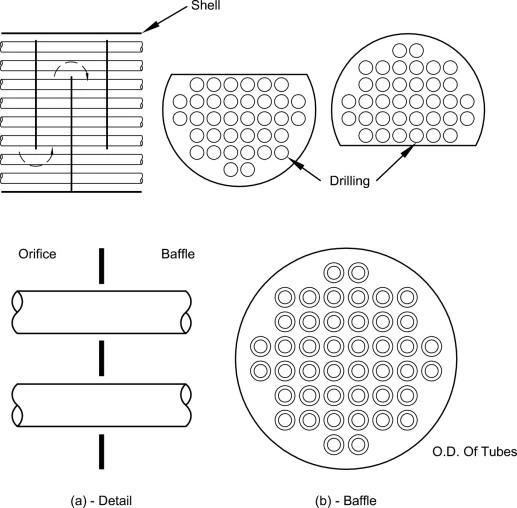Optimizing Heat Exchanger Performance with Baffle Design
Shell-and-tube heat exchangers are ubiquitous in industrial processes, directly impacting energy efficiency and operational costs. Among the key components of shell and tube heat exchanger, baffles play a critical role in determining heat transfer efficiency and overall performance. When designing and selecting baffles, several factors need to be considered, including baffle cut heights, spacing, and structural forms.

1. Impact of Baffle Cut Heights
The selection of baffle cut heights is a crucial factor influencing the performance of heat exchangers. Among various designs, the arch-shaped baffle is the most commonly used, with a cut height typically ranging from 0.20 to 0.45 times the inner diameter of the shell. Studies have shown that variations in baffle cut heights alter the fluid flow regime, thereby affecting heat transfer efficiency. For instance, an increase in baffle cut height correlates with a decrease in shell-side pressure drop and heat transfer coefficient. Furthermore, different cut orientations result in varying heat transfer coefficients and pressure drops, with the highest coefficient observed for vertical cuts and the lowest for horizontal cuts.
2. Effect of Baffle Spacing
Baffle spacing is another critical factor impacting heat exchanger performance. The minimum spacing between baffles should be no less than one-fifth of the shell diameter or 50 mm. Smaller spacings lead to higher natural frequencies of heat transfer tubes, resulting in increased shell-side pressure drop and improved heat transfer efficiency. Research indicates that spiral baffles exhibit lower pressure losses compared to arch-shaped baffles, with an associated increase in heat transfer coefficient as flow rates rise. However, increasing baffle spacing leads to a decrease in shell-side heat transfer coefficient and pressure drop.
3. Influence of Baffle Structural Forms
Different structural forms of baffles exhibit distinct flow and heat transfer characteristics. Common structural forms include arch-shaped, spiral, disk-ring, and fan-shaped baffles. Studies have demonstrated that heat exchangers equipped with spiral baffles outperform those with arch-shaped baffles in terms of shell-side heat transfer coefficient and overall performance, albeit with higher shell-side pressure losses. Under similar operating conditions, fan-shaped baffles exhibit the most rational pressure distribution, while disk-ring baffles promote more uniform velocity distribution, advantageous for mitigating equipment vibration and wear. However, arch-shaped baffle heat exchangers experience significant temperature fluctuations.
In conclusion, baffles play a pivotal role in shell-and-tube heat exchangers, with their design and selection profoundly impacting performance enhancement and energy utilization efficiency. To achieve optimal heat transfer effectiveness and operational cost reduction, a holistic consideration of baffle cut heights, spacing, and structural forms is essential. Through judicious baffle design, it is possible to significantly enhance the performance of shell-and-tube heat exchangers, providing reliable support for industrial processes.

